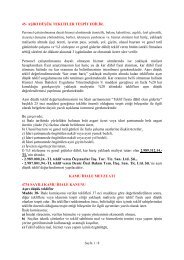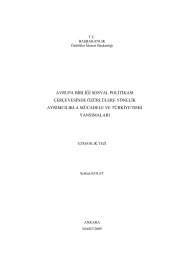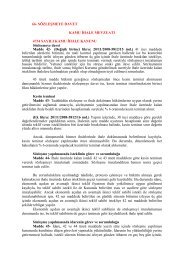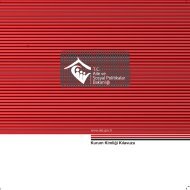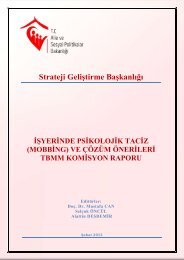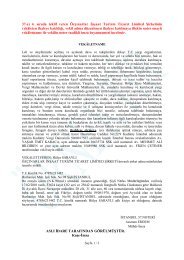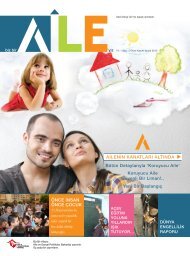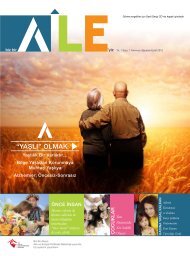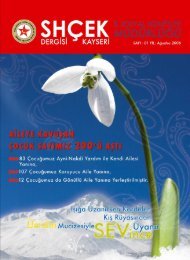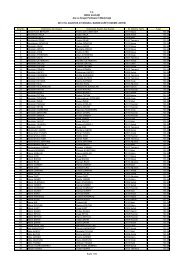Sosyal PolÄ°tÄ°ka tÄ°ka - EÄitim ve Yayın Dairesi BaÅkanlıÄı - Aile ve ...
Sosyal PolÄ°tÄ°ka tÄ°ka - EÄitim ve Yayın Dairesi BaÅkanlıÄı - Aile ve ...
Sosyal PolÄ°tÄ°ka tÄ°ka - EÄitim ve Yayın Dairesi BaÅkanlıÄı - Aile ve ...
- No tags were found...
You also want an ePaper? Increase the reach of your titles
YUMPU automatically turns print PDFs into web optimized ePapers that Google loves.
A CRITICAL ASSESSMENT ON THE CONDITIONAL CASH TRANSFER PROGRAMME<br />
IN THE CONTEXT OF GENDERED POVERTY IN TURKEY<br />
Mehmet Ali KÜÇÜKÇAVUŞ<br />
women in political forums and education attainments and women’s participation in<br />
labour market. To sustain a sound index, GII also uses different types of indictors varying<br />
including maternal mortality ratio, adolescent fertility rate, shares of parliamentary<br />
seats and education attainment le<strong>ve</strong>ls and women’s participation in the work<br />
force (UNDP, 2011b). This article will again refer again these measures and index so<br />
as to picture gendered po<strong>ve</strong>rty in Turkey.<br />
2.1. Gendered Nature of Po<strong>ve</strong>rty in Turkey<br />
In the context of gender equality and gendered po<strong>ve</strong>rty, Turkey has showed a <strong>ve</strong>ry<br />
poor performance compared to its economic de<strong>ve</strong>lopment le<strong>ve</strong>l. For instance, it ranked<br />
83rd among 169 countries which the relevant data was available according to<br />
GII in UNDP Human De<strong>ve</strong>lopment Report 2010. As mentioned abo<strong>ve</strong>, GII includes<br />
specific indicators to measure inequality and re<strong>ve</strong>al gendered nature of po<strong>ve</strong>rty. The<br />
labour force participation ratio which is one of these indicators and <strong>ve</strong>ry important<br />
to expose discrimination against women in labour market has remained quite low<br />
as 26.9 percent (UNDP, 2010, p.157). Similar to GII in UNDP Human De<strong>ve</strong>lopment<br />
Report 2010, Turkey has placed 99th out of 134 countries in participation ratio of<br />
women in political forums in the Gender Gap Report 2010 (World Economic Forum,<br />
2010).<br />
Except abo<strong>ve</strong> mentioned comparati<strong>ve</strong> data, there is a serious constraint in obtaining<br />
relevant empirical study to picture the gendered nature of po<strong>ve</strong>rty in Turkey (Candas<br />
and Bugra, 2010, p.29). The main underlying reason of this scarcity is that existing<br />
official statistics are generally based on household and ignore disparities in these<br />
households. That these statistics are unable to contribute policy making process has<br />
formed other reason (Sener, 2009, p.6). Consequences of limited empirical studies<br />
and insufficient statistics on gendered nature of po<strong>ve</strong>rty in Turkey will be debated in<br />
details in the conclusion section of this article. Howe<strong>ve</strong>r, there is, at this stage, a need<br />
to address on se<strong>ve</strong>ral selected official statistics in order to re<strong>ve</strong>al gendered nature of<br />
po<strong>ve</strong>rty in Turkey.<br />
Table I shows the po<strong>ve</strong>rty rates in last fi<strong>ve</strong> years according to education le<strong>ve</strong>ls of male<br />
and female members of households in Turkey. These official statistics reflect that<br />
women, on the a<strong>ve</strong>rage, experience po<strong>ve</strong>rty more frequently than man in Turkey.<br />
Despite that, the risk of falling into po<strong>ve</strong>rty for the women decreases as the education<br />
le<strong>ve</strong>l of women impro<strong>ve</strong>s.<br />
49



